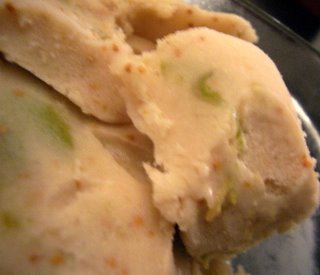 Go figure. "Fig" is not just just a sweet jammy paste that sits in the middle of a Newton. It is, in fact, a real live round globule of fruit. And right now is a perfect time to enjoy fresh ones. A fig is not just a fig, it is an inverted strawberry. It's true! The strawberry underlies the true fruits, which speckle its outside, while a fig surrounds its true fruit, which are in the center. What you think are seeds are actually tiny dried fruits! How cute!
Go figure. "Fig" is not just just a sweet jammy paste that sits in the middle of a Newton. It is, in fact, a real live round globule of fruit. And right now is a perfect time to enjoy fresh ones. A fig is not just a fig, it is an inverted strawberry. It's true! The strawberry underlies the true fruits, which speckle its outside, while a fig surrounds its true fruit, which are in the center. What you think are seeds are actually tiny dried fruits! How cute!But what is really fascinating is the sex life of a fig. Figs have a complex interspecies relationship going on with what is described as "a tiny wasp." In order to pollinate the florets inside, the fig has a little pore on the bottom through which the tiny wasp will enter to pollinate. I'm going to pretend I never learned that.
Some fig varieties can set fruit without pollination and produce seeds with no embryo. The way a fig reproduces affects its flavor, apparently. The figs fertilized by wasps are also more prone to spoilage. Calimyrna figs, which are common in California, must be fertilized. Farmers will bring in bags of wasps and have special separate "caprifigs" that are inedible and are solely to provide a source of fig pollen and a place for the wasps to lay their eggs. Let's hope never to accidently get one of these!
And now for a little history. Where do these strange fruits come from? Figs are native to the Mediterranean and Middle East and are relatives of the mulberry. They have been an important food source for thousands of years, because they easily sun-dry which allows them to be kept for a longer period of time before eating. The fig is the fruit most often mentioned in the Bible. And how did they get here? The fig came to America via Mexico along with the Spanish explorers and has thrived here.
Did you know that fruit has a metabolism? I did not ... at least I did not think of it that way. Not that I really have a great understanding of what metabolism is. I just kind of imagine it as how fast everything is moving around in your body. Like, I imagine a person with a quick metabolism as having blood pumping really fast and their muscles all do things really fast and their organs all work really fast. Of course I know that's the Sesame Street view of what metabolism actually is, although less accurate than Sesame Street would be, but it's all I have to work with when it comes to science. The point being that fruit has a metabolism just like humans do and figs have a naturally high metabolism and deteriorate faster than lethargic fruits and vegetables. What does this mean? If you buy fresh figs, you should be prepared to eat them right away because they will get soft and mushy right quick. As I learned to my chagrin a few weeks ago. You see, because of this fast metabolism and because they are 80% water, figs are very perishable. They do not improve after harvest and will steadily deteriorate after being picked. Their optimal storage temperature is 32 degrees F, or 0 degrees C, but the best way to keep figs is to dry them.
Nutritionally, figs contain antioxidants and also have a significant amount of calcium for a fruit.
The picture you see above is a fig and honey gelato as featured in Russ Parsons' article for the LA Times about figs, which my dear husband made especially for my gelato lovin' booty. It was delicious in flavor--it was very sweet and retained all the richness of flavor of the ripe fruit. --despite the fact that I was weirded out by the oh-so-'80s pink and green color combo.
SOURCE OF INFO: Harold McGee, "On Food and Cooking"
Tags:
Comments
Sooslo: Thank you! How did you make it do Greek letters?
Is that weird? Wait, don't answer . . .
I love Fig Newtons. Is THAT weird?